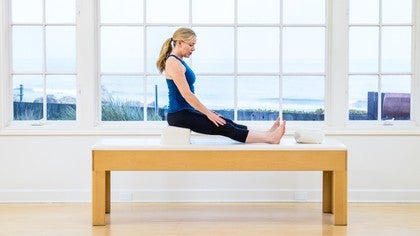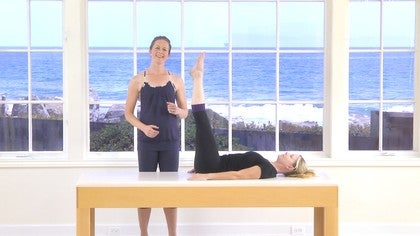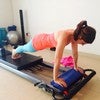Description
About This Video
Transcript
Read Full Transcript
Hello everybody. I am Carrie Macy and I'm so happy to be here today with Amy havens to assist me. I would like to tell, talk to you today about some common cues that you often hear in many videos that you may see on Flonase anytime or in many classes that you may take. And well, I will use the a hundred as an exercise example for all of these cues and then we'll break them down a little bit and get to understand them a little bit better so that when you hear these cues in videos that you may watch, it will make more sense to you and you'll be able to get a deeper and stronger workout at that point. Okay, so for the hundred we will have Amy go ahead and lie down on her back. And three common cues that we'll focus on today are number one, engage your abdominals. I'm sure you've heard that a lot. Number two, connect your lats, which again is another common one.
And the third one is to wrap your thighs. Okay. These are all very important ideas to perform [inaudible] correctly, but they are, sometimes we don't really quite understand what they might mean. All right, so I'm just going to teach Amy the a hundred and I will use all of those cues in teaching it to her. Okay, so first Amy, bring your knees into your chest, curl your head and shoulders up off of the mat and extend your legs out to 45 degrees. Lift your arms up to hip level and begin to pump your arms vigorously by your side. She takes the big breath in and a big breath out. Okay, continuing me. So I just set her up. She's going in her hundred and now I might start to say some of those cues. Amy, engage your abdominals deeper. Good. And now Amy, connect to your lats, down your back, and then wrap the backs of your thighs together. Good.
And take one more breath in. One more breath out and finish. Bend your knees and rest your head. Good. Probably sounds like a familiar class cue, right, that you've heard before. All right, so let's break each one of those down a little bit more. What does engage your abdominals mean?
It could mean lots of things to lots of different people and employees. We want you to engage your abdominals in a very specific way. That's kind of a little bit complicated actually. Some parts of your abdominal muscles are going to be concentrically contracting, which means the muscles get shorter and tighter while other parts of your abdominals. The lower portion will actually be east centric. Lee Contracting, making the muscles longer or appear longer, and that part is what will give you that hollow scoop. You may also hear that very often. Scoop your abdominals.
We're looking in pilates for this deepening or hollowing of the abdominals. Okay, so I'm just going to have Amy curl her head and shoulders up off of the mat. When she does that. The upper portion of Rectus abdominis is definitely concentrically contracting. That means the muscle fibers are getting shorter and it's producing the lovely top of the six pack that Amy has underneath her shirt. Good.
Okay, so that's what's happening in the top. Now in the bottom half, the lower part of her rectus abdominis is actually essentially [inaudible] contracting. So Amy, I want you to feel like the muscles are kind of scooping and spreading wider. Yes. And then to top it all off, what we'd want her to do is to concentrically so it's going to squeeze tighter. Her transverse abdominous, which is another layer of abdominals that we'll send to her waist to make it tighter. So she has a very hollow and tight little waist going on there. Good. You can rest your head down, Huh? All right. So that's a lot.
But that's the idea that you guys want to feel when someone says engage your abdominals. It's a contraction, but it's also this deepening and melting in addition to a squeezing in. Okay. Now the connect your lats. So that idea, what we're trying to get at is that your arm bone, it's connected down your body into your back. And sometimes people know what their laps are. Sometimes you may not know what your locks are and what does it mean to connect them? Where do you want to connect them? Right? And so in [inaudible] we want them to contract down towards your waist.
So an easy way to get this in the hundred I'm going to have Amy curl her head and shoulders that began. First off, she needs to widen her collar bones. Okay. That's going to open the chest and not allow her shoulders to fold forward. Then I want her to reach her fingertips all the way down to the end of the mat, like she's trying to touch the very end of the mat without collapsing her chest open. [inaudible] very good. And just that action right there will get her to connect her labs so the labs would be here on the side of her body. Do you feel a connection there? Beautiful. I'm going to relax your head. Good. All right.
The final cue we'll talk about is the wrapping of the thighs. So I'm just going to have you take your leg straight to the ceiling. Normally we'll do the a hundred with the legs at a different angle, but to save Amy's back and whatnot, I'll just tell her go straight up is perfectly fine. All right, so the wrapping of the thighs, what we're trying to get you to do with that is to use the muscles of your hips and the backs of your legs. So the tops of your glutes and your hamstrings and your inner thighs to squeeze together tighter so that you have a tighter center and all of your muscles are coming together in that center. So an easy way to think about this when someone says wrap your thighs is to first externally rotate your OSI bone.
So that means your toes will turn to face out. Your knees will also turn to face. And then try to press your legs together as hard as you can, all the way from your hips to your heels and you will engage all of those muscles automatically getting the idea that we're going for. Do you feel that? Oh good. And then bend your knees. Perfect. Okay, so now I will cue Amy through the hundred using slightly different cues.
I'm not going to say wrap your thighs, engage your abdominals, or connect your lats. I'm going to see it slightly differently and hopefully it will make her feel the exercise just a little bit more. Okay, so Amy, bring your knees all the way into your chest. Bring your head up to your knees. Try to touch your forehead to your knees. So bring your knees in your head as close as you can. This gets her to engage her abdominals, but I didn't tell her to do that.
Then extend your legs to 45 degrees, but keep that lift in the body. Lift your arms up to hip level and begin your pumps. Start you're breathing in and you're exhaling out. Okay, so from here, deepen your ribs down into the mat. Curl over my fingers more. Good. And then find heaviness in your pelvis.
Press your sacrum into the mat that engaged her upper rectus concentrically and it helps her to east central, typically contract her lower. Keep going, Amy, are, you're doing great. Now I'm going to talk about her lap. Open your collarbones and reach your hands all the way towards the end of the mat. Keep your elbows stick straight as you're pumping you tuffle. And now I will talk about the wrapping of the thighs. So front with her legs. One her to EQ, sternal Lee, rotate her thighs, and then squeeze your legs together from your hips all the way to your heels. Don't let my hands slip through. Beautiful. Now do one more big breath in.
Big Breath out. And relax. Bend your knees. Rest your head. Alright, so Amy, bring yourself to the seat in and tell us how did that second hundred feel any different than the first hundred? It felt more powerful. I definitely felt more as they just sit here for a moment. I feel more all inclusive. Wonderful. The whole body in power. Good. Awesome. So in conclusion, these cues and the ideas behind them work for almost every PyLadies exercise.
So as you're practicing on your own and watching more videos, keep them in mind and it'll make your workout stronger and more effective for you each time that you do it. And I would love to hear your comments about this. If you have any questions or any ideas, uh, I've welcome your feedback.
The Successful Beginner - Playlist 1: Tips for Success
Comments
You need to be a subscriber to post a comment.
Please Log In or Create an Account to start your free trial.






















